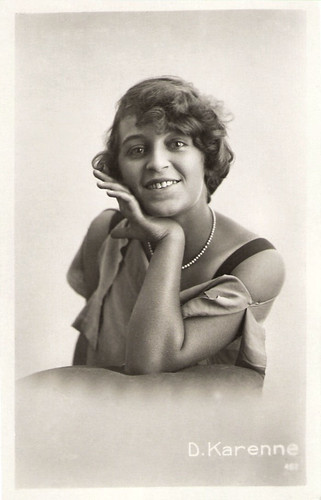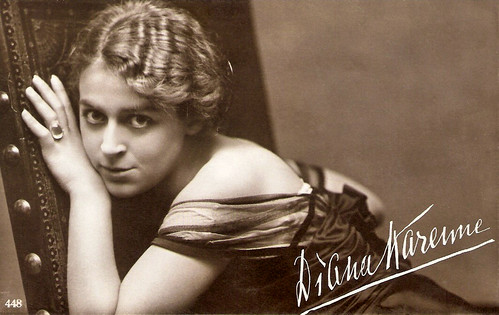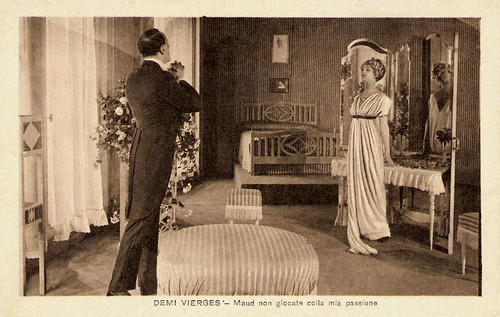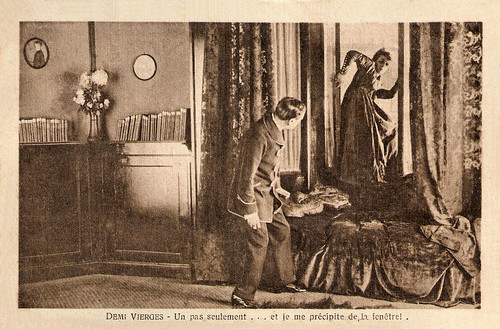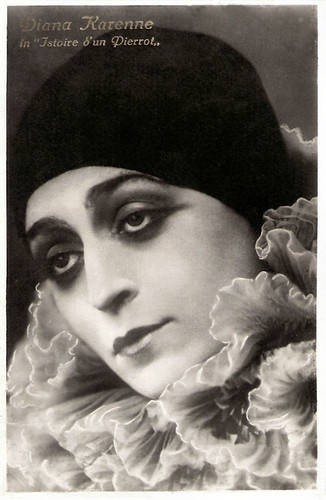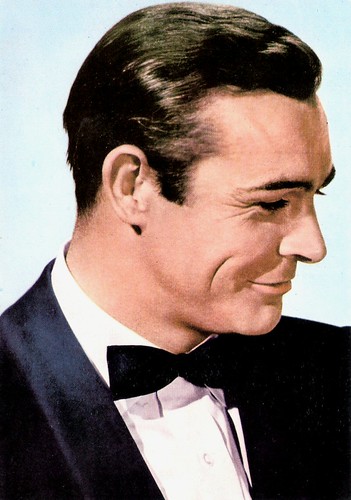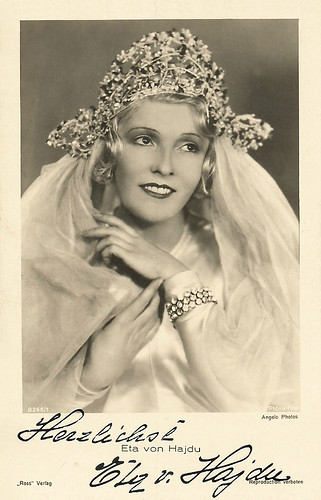English stage, film, and television actor Reginald Denny (1891-1967) was also an aviator and a pioneer in the field of radio controlled, pilotless aviation. He appeared in more than 200 films, both in Great-Britain and in the United States, first as a lead in silent films and later as a character actor in sound films and TV productions.
![Reginald Denny]()
French postcard by Editions Cinémagazine, Paris, no. 295.
![Reginald Denny]()
French postcard by Cinémagazine-Edition, Paris, no. 334.
![Reginald Denny]()
French postcard, no. 110.
Acting and Flying
Reginald Denny was born Reginald Leigh Dugmore in Richmond, England in 1891. He was the last in a long line of British actors. His father was the actor and singer W. H. Denny, a member of the Gilbert and Sullivan Opera Company, and his brother was actor Malcolm Denny. Reginald attended St. Francis Xavier College in Mayfield, Sussex, but at 16, he choose for the family trade and in 1908, he went to the US with his family to act in the play The Quaker Girl. Cutting a dashing figure with his athletic good looks, he joined a travelling company of The Merry Widow in 1912, that toured the US, India, and parts of the Far East. Later that year he returned to England and made his debut in a few early British films of which the titles are lost. With a fine baritone voice he also toured with the Bandmann Opera Company. In 1915 he appeared in his first American film, Niobe (Hugh Ford, Edwin S. Porter, 1915). In 1917, Denny joined the 112th squadron of the Royal British Flying Corps as a pilot and remained for a two-year hitch as a lieutenant, during which he also became the brigade heavyweight-boxing champion. Denny took his acting and flying experiences with him to settle in America in 1919 where his acting career took off in earnest. He appeared in the silent films Bringing Up Betty (Oscar Apfel, 1919) and The Oakdale Affair (Oscar Apfel, 1919) for the New Jersey based World Film Corporation. Reginald had earlier become friends with actor John Barrymore and appeared in Barrymore's acclaimed 1920 Broadway production of Richard III. From then on, he appeared in several more Broadway productions.
![Reginald Denny]()
German postcard by Ross Verlag, no. 3202/1, 1928-1929. Photo: Universal-Matador.
![Reginald Denny]()
Austrian postcard by Iris-Verlag, no. 5324. Photo: Universal-Film.
![Reginald Denny]()
Austrian postcard by Iris Verlag, no. 492.
Fixture
Through the Silent Era, Reginald Denny became something of a fixture in American films – he played nearly 60 roles in comedy and drama. His leading roles covered everything from action hero to straight-laced English lord. On several films he worked as a stunt pilot and in the Universal action series The Leather Pushers (Edward Laemmle, 1922) he showed his boxing ability in the lead role. During the 1920s, Denny was one of Universal's most popular stars, headlining a series of light comedies, like Sporting Youth (Harry A. Pollard, 1924) and Skinner's Dress Suit (William A. Seiter, 1926), which both co-starred Laura LaPlante. Combining humor with his handsome physique and chiseled, matinee idol looks, gave him a romantic edge. Other notable silent films with him were Sherlock Holmes (Albert Parker, 1922) with John Barrymore, and On Your Toes (Fred C. Newmeyer, 1927). It was not until 1929 and his first role in a mono picture - silent but with limited sound effects and dialogue - that the public realized he was British. With a fine, modulated voice he easily entered the talking era of film and was in fact one of the early emcees for The Voice of Hollywood No. 3 (1930) series of filmed radio shows. Denny's British accent made it difficult for him to continue in the ´all-American´ roles he'd been playing at Universal, but he continued to flourish as a character actor in the sound era. He played the lead role in a number of his earlier sound films, generally as a comedic Englishman in such works as the Noel Coward adaptation Private Lives (Sidney Franklin, 1931) starring Norma Shearer. In the early 1930s, Denny became interested in radio controlled model planes. He and his business partners formed Reginald Denny Industries opened a model plane shop in 1934. In 1940, Denny and his partners won an Army contract for their radio-controlled target drone, the OQ-2 Radioplane. They manufactured nearly fifteen thousand drones for the army during World War II. The company was purchased by Northrop in 1952. The hobby shop business closed in the 1960s.
![Reginald Denny]()
British postcard.
![Reginald Denny]()
Austrian postcard by Iris-Verlag.
![Reginald Denny]()
British postcard in the Picturegoer series, no. 74. Photo: Freulich.
B Leads and A Seconds
Meanwhile Reginald Denny had reasonably steady work as a supporting actor in dozens of films, including The Little Minister (Richard Wallace, 1934) with Katharine Hepburn, and Anna Karenina (Clarence Brown, 1935) with Greta Garbo. He also played the ´silly ass´ second lead of Algy in several Bulldog Drummond B pictures, such as Bulldog Drummond Comes Back (1937, Louis King). Though there was no lack of roles, his earlier B leads became A seconds and character parts as the 1930s progressed into the war years to follow. According to William McPeak at IMDb“Denny was a fine actor with depth. His fine physique and healthy face could fit all occasions from the earlier ensemble film The Lost Patrol (John Ford, 1934) with Victor McLaglen to a memorable second lead to Leslie Howard in the powerful Of Human Bondage (John Cromwell, 1934) featuring an incredible performance by Bette Davis. His theater experience showed well in the gorgeously filmed Romeo and Juliet (George Cukor, 1936) as a versatile Benvolio to Leslie Howard again as Romeo. Among other films into the next decade his range of subtle emotion was sensitively revealed in his portrayal of lawyer/friend Frank Crawley to Laurence Olivier as disturbed Maxim de Winter in Rebecca (Alfred Hitchcock, 1940)”. Although his film work continued into the late 1940s, by the 1950s he was no stranger to television, especially the progression of TV playhouse fare, where he could still do some serious acting. But he was also quite well known in episodic TV in many cameo roles in drama and light comedy. He returned to Broadway in 1958 to replace Robert Coote as Col. Pickering in My Fair Lady. His last film roles were in Cat Ballou (Elliot Silverstein, 1965), starring Lee Marvin, the Frank Sinatra crime caper film Assault on a Queen (Jack Donohue, 1966), and as Commodore Schmidlapp in Batman (Leslie Martinson, 1966). Although Reginald Denny adopted America and made his home in California, he passed away in Richmond, the town of his birth. He suffered a stroke while he and his wife were visiting his sister in 1967. He was already battling cancer. Denny married twice. He was married to British musical comedy star Irene Haisman from 1913 till 1927. They had one child, Barbara. In 1928 he married actress Isobel Steiffel (aka Betsy Lee), with whom he would have three children.
![Reginald Denny]()
British postcard of a third series of '50 Cinema Stars' issued with Sarony Cigarettes, no. 48.
![Reginald Denny]()
Dutch postcard, no. 164.
![Reginald Denny]()
British postcard of a fifth series of '50 Cinema Stars' issued with Sarony Cigarettes, no. 19.
Reginald Denny with Kay Johnson in Madam Satan (1930). Source: Ray85Milan (YouTube).
Sources: William McPeak (IMDb), Hal Erickson (AllMovie), Tim Lussier (Silents are Golden), Wikipedia, and IMDb.

French postcard by Editions Cinémagazine, Paris, no. 295.

French postcard by Cinémagazine-Edition, Paris, no. 334.

French postcard, no. 110.
Acting and Flying
Reginald Denny was born Reginald Leigh Dugmore in Richmond, England in 1891. He was the last in a long line of British actors. His father was the actor and singer W. H. Denny, a member of the Gilbert and Sullivan Opera Company, and his brother was actor Malcolm Denny. Reginald attended St. Francis Xavier College in Mayfield, Sussex, but at 16, he choose for the family trade and in 1908, he went to the US with his family to act in the play The Quaker Girl. Cutting a dashing figure with his athletic good looks, he joined a travelling company of The Merry Widow in 1912, that toured the US, India, and parts of the Far East. Later that year he returned to England and made his debut in a few early British films of which the titles are lost. With a fine baritone voice he also toured with the Bandmann Opera Company. In 1915 he appeared in his first American film, Niobe (Hugh Ford, Edwin S. Porter, 1915). In 1917, Denny joined the 112th squadron of the Royal British Flying Corps as a pilot and remained for a two-year hitch as a lieutenant, during which he also became the brigade heavyweight-boxing champion. Denny took his acting and flying experiences with him to settle in America in 1919 where his acting career took off in earnest. He appeared in the silent films Bringing Up Betty (Oscar Apfel, 1919) and The Oakdale Affair (Oscar Apfel, 1919) for the New Jersey based World Film Corporation. Reginald had earlier become friends with actor John Barrymore and appeared in Barrymore's acclaimed 1920 Broadway production of Richard III. From then on, he appeared in several more Broadway productions.

German postcard by Ross Verlag, no. 3202/1, 1928-1929. Photo: Universal-Matador.

Austrian postcard by Iris-Verlag, no. 5324. Photo: Universal-Film.

Austrian postcard by Iris Verlag, no. 492.
Fixture
Through the Silent Era, Reginald Denny became something of a fixture in American films – he played nearly 60 roles in comedy and drama. His leading roles covered everything from action hero to straight-laced English lord. On several films he worked as a stunt pilot and in the Universal action series The Leather Pushers (Edward Laemmle, 1922) he showed his boxing ability in the lead role. During the 1920s, Denny was one of Universal's most popular stars, headlining a series of light comedies, like Sporting Youth (Harry A. Pollard, 1924) and Skinner's Dress Suit (William A. Seiter, 1926), which both co-starred Laura LaPlante. Combining humor with his handsome physique and chiseled, matinee idol looks, gave him a romantic edge. Other notable silent films with him were Sherlock Holmes (Albert Parker, 1922) with John Barrymore, and On Your Toes (Fred C. Newmeyer, 1927). It was not until 1929 and his first role in a mono picture - silent but with limited sound effects and dialogue - that the public realized he was British. With a fine, modulated voice he easily entered the talking era of film and was in fact one of the early emcees for The Voice of Hollywood No. 3 (1930) series of filmed radio shows. Denny's British accent made it difficult for him to continue in the ´all-American´ roles he'd been playing at Universal, but he continued to flourish as a character actor in the sound era. He played the lead role in a number of his earlier sound films, generally as a comedic Englishman in such works as the Noel Coward adaptation Private Lives (Sidney Franklin, 1931) starring Norma Shearer. In the early 1930s, Denny became interested in radio controlled model planes. He and his business partners formed Reginald Denny Industries opened a model plane shop in 1934. In 1940, Denny and his partners won an Army contract for their radio-controlled target drone, the OQ-2 Radioplane. They manufactured nearly fifteen thousand drones for the army during World War II. The company was purchased by Northrop in 1952. The hobby shop business closed in the 1960s.

British postcard.

Austrian postcard by Iris-Verlag.

British postcard in the Picturegoer series, no. 74. Photo: Freulich.
B Leads and A Seconds
Meanwhile Reginald Denny had reasonably steady work as a supporting actor in dozens of films, including The Little Minister (Richard Wallace, 1934) with Katharine Hepburn, and Anna Karenina (Clarence Brown, 1935) with Greta Garbo. He also played the ´silly ass´ second lead of Algy in several Bulldog Drummond B pictures, such as Bulldog Drummond Comes Back (1937, Louis King). Though there was no lack of roles, his earlier B leads became A seconds and character parts as the 1930s progressed into the war years to follow. According to William McPeak at IMDb“Denny was a fine actor with depth. His fine physique and healthy face could fit all occasions from the earlier ensemble film The Lost Patrol (John Ford, 1934) with Victor McLaglen to a memorable second lead to Leslie Howard in the powerful Of Human Bondage (John Cromwell, 1934) featuring an incredible performance by Bette Davis. His theater experience showed well in the gorgeously filmed Romeo and Juliet (George Cukor, 1936) as a versatile Benvolio to Leslie Howard again as Romeo. Among other films into the next decade his range of subtle emotion was sensitively revealed in his portrayal of lawyer/friend Frank Crawley to Laurence Olivier as disturbed Maxim de Winter in Rebecca (Alfred Hitchcock, 1940)”. Although his film work continued into the late 1940s, by the 1950s he was no stranger to television, especially the progression of TV playhouse fare, where he could still do some serious acting. But he was also quite well known in episodic TV in many cameo roles in drama and light comedy. He returned to Broadway in 1958 to replace Robert Coote as Col. Pickering in My Fair Lady. His last film roles were in Cat Ballou (Elliot Silverstein, 1965), starring Lee Marvin, the Frank Sinatra crime caper film Assault on a Queen (Jack Donohue, 1966), and as Commodore Schmidlapp in Batman (Leslie Martinson, 1966). Although Reginald Denny adopted America and made his home in California, he passed away in Richmond, the town of his birth. He suffered a stroke while he and his wife were visiting his sister in 1967. He was already battling cancer. Denny married twice. He was married to British musical comedy star Irene Haisman from 1913 till 1927. They had one child, Barbara. In 1928 he married actress Isobel Steiffel (aka Betsy Lee), with whom he would have three children.

British postcard of a third series of '50 Cinema Stars' issued with Sarony Cigarettes, no. 48.

Dutch postcard, no. 164.

British postcard of a fifth series of '50 Cinema Stars' issued with Sarony Cigarettes, no. 19.
Reginald Denny with Kay Johnson in Madam Satan (1930). Source: Ray85Milan (YouTube).
Sources: William McPeak (IMDb), Hal Erickson (AllMovie), Tim Lussier (Silents are Golden), Wikipedia, and IMDb.








